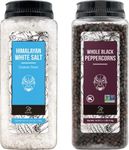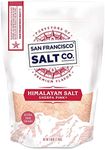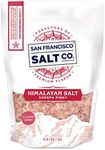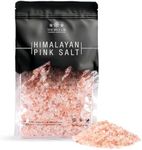Buying Guide for the Best Himalayan Salts
Choosing the right Himalayan salt can seem overwhelming with so many options available, but understanding the key features will help you make a choice that fits your needs. Himalayan salt is prized for its mineral content, unique flavor, and potential health benefits. Whether you’re looking for salt for cooking, therapeutic use, or decorative purposes, knowing what to look for will ensure you get the best product for your intended use.Grain SizeGrain size refers to how fine or coarse the salt crystals are. This is important because it affects how the salt dissolves and how it can be used. Fine grains are best for table use and cooking, as they dissolve quickly and blend easily with food. Medium grains are often used for finishing dishes or in salt shakers, providing a bit of crunch and visual appeal. Coarse grains are typically used in salt grinders or for decorative purposes, such as in salt lamps or bath salts. To pick the right grain size, think about how you plan to use the salt: for everyday cooking, fine or medium is best; for grinders or baths, go with coarse.
Purity and AdditivesPurity refers to how natural and unprocessed the salt is, and whether it contains any additives. Pure Himalayan salt is typically free from anti-caking agents or artificial ingredients, which is important if you want a natural product. Some salts may be mixed with other minerals or additives for specific uses, but for most culinary or therapeutic purposes, pure salt is preferred. Check labels for any added ingredients and choose pure salt if you want the most authentic experience.
ColorHimalayan salt naturally ranges in color from light pink to deep red, depending on its mineral content. The color can be important for both aesthetic and nutritional reasons, as darker salts may contain more trace minerals. Lighter pink salts are often used for table salt, while deeper hues are popular for decorative uses like salt lamps. If you care about the look or want higher mineral content, pay attention to the color, but for most cooking uses, any shade will work.
Intended UseHimalayan salt can be used for cooking, therapeutic baths, or as decorative items like lamps and candle holders. The intended use will guide your choice: food-grade salt is safe for eating and cooking, while larger chunks or blocks are better for grilling or serving. Bath salts are often coarser and may be mixed with essential oils. Decorative items are not meant for consumption. Always match the type of salt to your intended use to ensure safety and satisfaction.
PackagingPackaging affects freshness, ease of use, and storage. Himalayan salt is available in bags, jars, grinders, or bulk containers. Airtight packaging helps keep the salt dry and free from contaminants. If you use salt frequently, a resealable bag or jar is convenient. For occasional use or decorative purposes, packaging may be less important. Choose packaging that fits your usage habits and storage space.


















